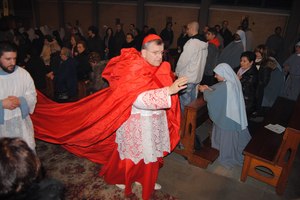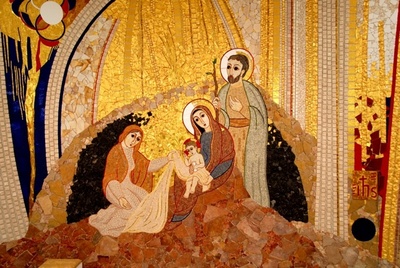Sacred Liturgy & Sacraments: December 2010 Archives
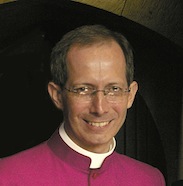
The worship of the Triune God is our single most important work. No other work of the faithful, laity and clergy alike, is equal to praise of God through the sacred Liturgy and personal prayer. Jason Horowitz of The Washington Post published an article on December 25, 2010, "Pope's master of liturgy helps Benedict restore traditions." Very interesting indeed. I, for one, am very grateful to Monsignor Guido Marini for the hard work he's done in helping the Church pray more authentically, particularly at the Liturgy celebrated by the Supreme Pontiff. A native of Genoa, born in 1965, Monsignor Marini is the Master of Pontifical Liturgical Celebrations, a position he's had since October 1, 2007. In a previous incarnation Marini served Cardinal Dionigi Tettamanzi (now archbishop of Milan) and Cardinal Tarcisio Bertone, SDB, (now Secretary of State), both former archbishops of Genoa. He earned a doctorate in the psychology of communication and also holds the duel doctorate in canon and civil law.
In Rome on
a rainy Christmas Eve, Pope Benedict XVI followed a procession of Swiss guards,
bishops and priests down the central nave of St. Peter's Basilica to celebrate
midnight Mass before dignitaries and a global television audience.
And
Monsignor Guido Marini, as always, followed the pope.
A tall, reed-thin cleric with a receding hairline and wire-framed glasses, Marini, 45, perched behind the pope's left shoulder, bowed with him at the altar and adjusted the pontiff's lush robes. As Master of Pontifical Liturgical Celebrations, he shadows the pope's every move and makes sure that every candle, Gregorian chant and gilded vestment is exactly as he, the pope and God intended it to be.
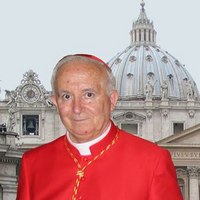 Andrea Tornielli published an interview with Antonio
Cardinal Cañizares Llovera, 65, from Spain, Prefect of the Congregation for
Divine Worship in Il Giornale, "Basta con la messa creativa, in chiesa
silenzio e preghiera" ["Enough with the Creative Mass, in Church
Silence and Prayer"].
Andrea Tornielli published an interview with Antonio
Cardinal Cañizares Llovera, 65, from Spain, Prefect of the Congregation for
Divine Worship in Il Giornale, "Basta con la messa creativa, in chiesa
silenzio e preghiera" ["Enough with the Creative Mass, in Church
Silence and Prayer"].This mosaic of the Holy Family is located in the Chapel at the Saint Peter Canisius, the Jesuit House of Writers located on the Borgo Spirito Santo, Rome. The mosaic is by Father Mark Rupnik, S.J. and the artisans of the Centro Alleti (Rome) December 23, 2007. Father Rupnik inspiration were the Contemplations on the Incarnation and the Nativity from Saint Ignatius of Loyola's Spiritual Exercises.
In the Exercises we read about
the Nativity. "The first point is [for me] to see the persons, that is, to see our
Lady, and Joseph, and the servant girl (the ancilla, the handmaid), and the
infant Jesus after he is born, making myself a poor little fellow and unworthy
little slave boy, looking at them, contemplating them, and serving them in
their needs as if I were there present, with all possible respect and
reverence."
A version of Father Rupnik's Holy Family mosaic is found in the Holy Family Chapel at the Knights of Columbus, Supreme Council, New Haven, Connecticut.
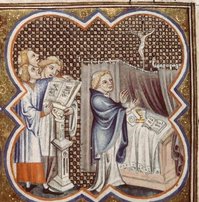 A friend started a few years ago, after doing the required study and catechesis, to celebrate the Sacrifice of the Mass facing East, or if you will, facing God. Father Kirby argues well his case for a priest to offer Mass suing the ad orientem gesture. And for goodness sake, don't call it "Mass with the priest's back to the congregation." It only shows ignorance of a proper liturgical tradition to say such. This aspect praying the Mass is met with fear and anger from bishops and seminary professors, not to mention pastors and laity that has more to do with a lack of understanding of liturgical prayer and too often agenda-ladened.
A friend started a few years ago, after doing the required study and catechesis, to celebrate the Sacrifice of the Mass facing East, or if you will, facing God. Father Kirby argues well his case for a priest to offer Mass suing the ad orientem gesture. And for goodness sake, don't call it "Mass with the priest's back to the congregation." It only shows ignorance of a proper liturgical tradition to say such. This aspect praying the Mass is met with fear and anger from bishops and seminary professors, not to mention pastors and laity that has more to do with a lack of understanding of liturgical prayer and too often agenda-ladened.2. The faithful are spared the tiresome clerocentrism that has so overtaken the celebration of Holy Mass in the past forty years.
3. It has once again become evident that the Canon of the Mass (Prex Eucharistica) is addressed to the Father, by the priest, in the name of all.
The Catholic Church in Ireland is facing what we in the USA continue to face and the Church in parts of the world also face or will face: sin. Archbishop Diarmuid Martin, Archbishop of Dublin, is working overtime to renew himself and the Church he leads to a deeper contrition and to a renewed sense of mission as a disciple of Jesus Christ. Like Saint John the Baptist, Archbishop Martin tells us clearly that self-centeredness and arrogance are not legitimate virtues for Catholics to allow to dwell in the heart and in the way one acts. What the Archbishop says about his Church can be said of us personally, and the Church in the USA. Time to change!!!! As the Baptist says, "I must decrease and He --Jesus-- must increase.

The Gospel of this morning's Mass recalls that great figure: John the Baptist. John's task was to announce the coming of Jesus. He was called to reawaken a sense of expectation among a people that had grown tired and distant from God. He was called to bring renewal to institutional expressions of religion which, at the time, had so often become fossilised into mere formulae or external ritual. John's work was extraordinary. He attracted thousands to come out into the desert to see him. He wrought conversion on a vast scale.
John was a man who stood out. His strange dress - the wild camel hair and the leather girdle - was not chosen as a publicity gimmick or a trademark. His message was one that spoke of rising above conventional ways of thinking, conventional expectations and attitudes. He shunned the external amenities of a comfortable life because he wanted to show his absolute dependence on God. His detachment from life's comforts gave him the freedom to truly recognise the message of Jesus.
The figure of John serves as a warning to us today, to all believers, to the Church and to Church organizations of every age of our need to draw our strength from Christ alone, rather than from identifying with the cultural patterns and fashions of the day, which in any case come and go.
